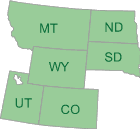Schedule a Pre-Application Meeting for a Clean Air Act Permit in Region 8
Region 8 implements CAA Permitting Programs, including PSD, Nonattainment Major NSR, and Minor NSR for 27 Tribal Nations in Colorado, Montana, North Dakota, South Dakota, Utah, and Wyoming, except on reservations where EPA has delegated the federal program or approved a Tribal Implementation Plan.
Because the permitting process can be very technically detailed and can include public participation and modeling, it can take anywhere from three months to one year to obtain a CAA pre-construction permit. Plan to submit your application well before the proposed construction and start-up date of the source. Plan to submit an operating permit application no later than 12 months after the source begins operations. The amount of review time required for a permit application depends on a number of factors, including completeness of the application, the complexity of the proposed or operating source, the number of applications currently under review, and current staffing levels and expertise. Permit applications will generally be reviewed in the order that they are received.
| Type of Permit Application | General Permit Issuance Timeframe |
|---|---|
| Minor source without public comments received or refined dispersion modeling | ~ 60 - 90 days |
| Minor source with public comment received and/or refined dispersion modeling | ~ 90 - 135 days |
| Synthetic minor source, minor modification at an existing major source, or PSD source without public comments received, or refined dispersion modeling | ~ 120 - 180 days |
| Synthetic minor source, minor modification at an existing major source, or PSD source with public comments received and/or refined dispersion modeling | ~ 6 - 12 months |
| Title V Operating Permit for source with few applicable requirements and/or without public comments received | ~120-180 days |
| Title V Operating Permit for source with multiple applicable requirements and/or with public comments received | ~ 6 - 12 months |
EPA encourages all applicants of CAA permits to schedule a meeting with the EPA prior to submitting a permit application, to ensure submittal of a complete application and minimize application review time. To schedule a pre-application meeting, contact the appropriate staff lead:
- Tribal NSR and PSD Permits Lead: Claudia Smith (smith.claudia@epa.gov), (303) 312-6520
- Title V (40 CFR Part 71) Operating Permits Lead: DJ Law (law.donald@epa.gov), (303) 312-7015
Applying for Pre-Construction PSD and NSR Permits
Applying for PSD or Nonattainment Major NSR Permits
Given the vast differences and technical complexities in the types of sources requiring PSD and Nonattainment Major NSR permits, the EPA does not have standard application forms. Please review information on the EPA's national website for information on PSD Permits and Nonattainment Major NSR Permits and schedule a pre-application meeting with Region 8.
Applying for Tribal Minor NSR Permits
Pre-Construction Modeling Guidance
Dispersion modeling for criteria pollutants and air toxics may be required as part of a pre-construction permit application for your facility to ensure protections of the National Ambient Air Quality Standards (NAAQS) in areas classified as attainment, attainment/unclassifiable or unclassifiable for the NAAQS. Modeling is generally required for all proposed new and modified PSD projects classified as a "major stationary source" or "major modification to an existing major stationary source". Information on the modeling required is found on the EPA's websites for PSD Permits and Clean Air Act Permit Modeling Guidance.
Region 8 is developing guidance for when modeling will be required for proposed new minor sources, minor modifications at an existing minor sources, synthetic minor sources or modifications, or minor modifications at existing major sources in Indian country. Keep visiting this page for updates on available minor source modeling guidance for Indian country. Until guidance is available, consult guidance available from the state CAA permitting jurisdictions near the area of Indian country your proposed project will be located and schedule a pre-application meeting with Region 8 for project-specific modeling guidance.
Applying for Part 71 Operating Permits
Map of Region 8 States

